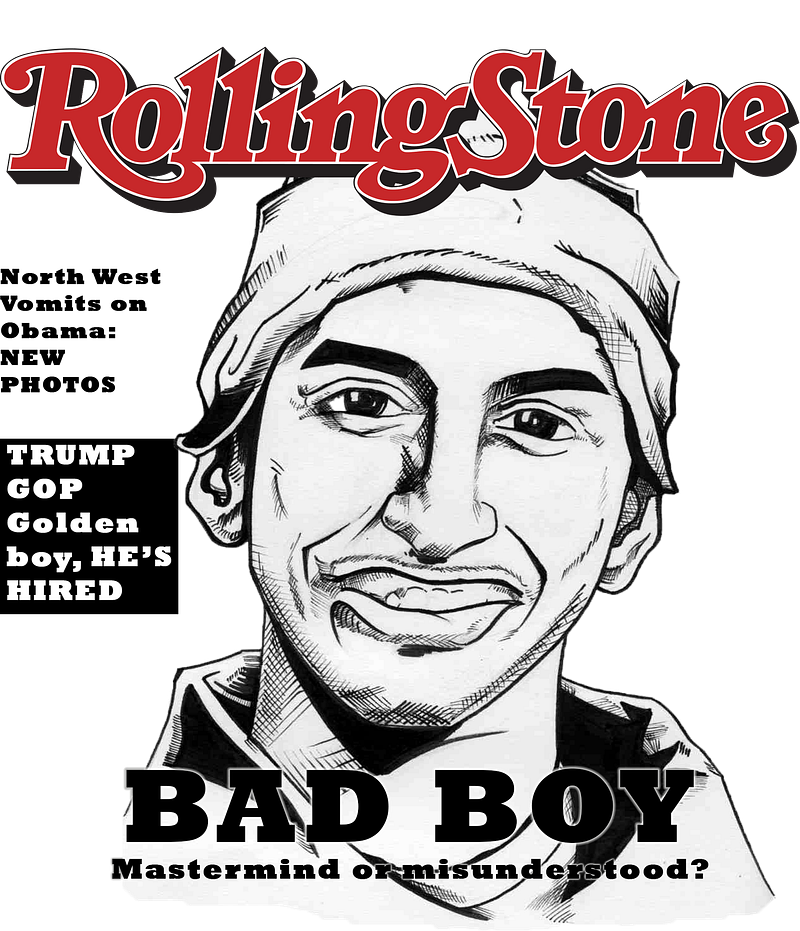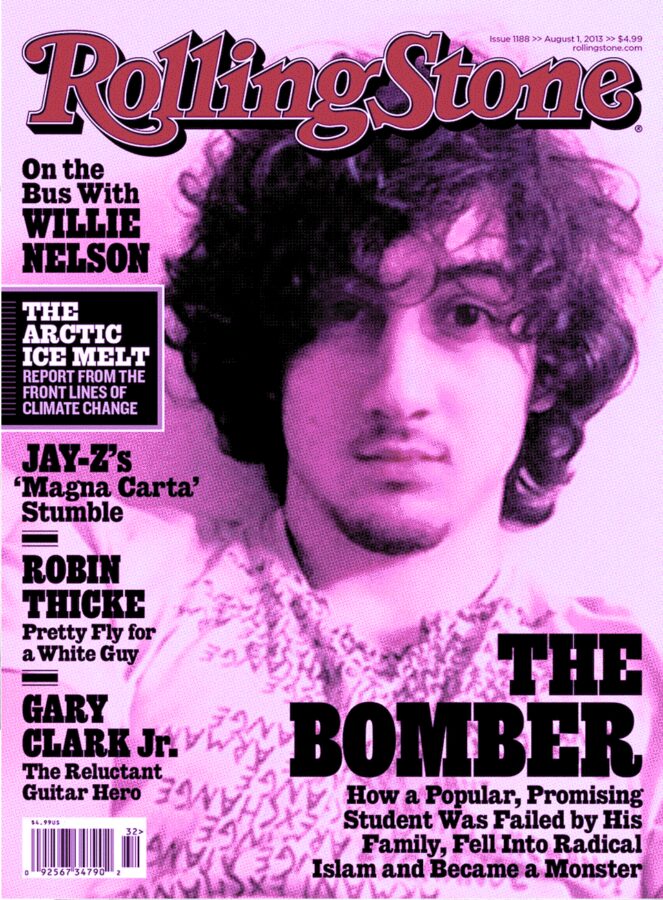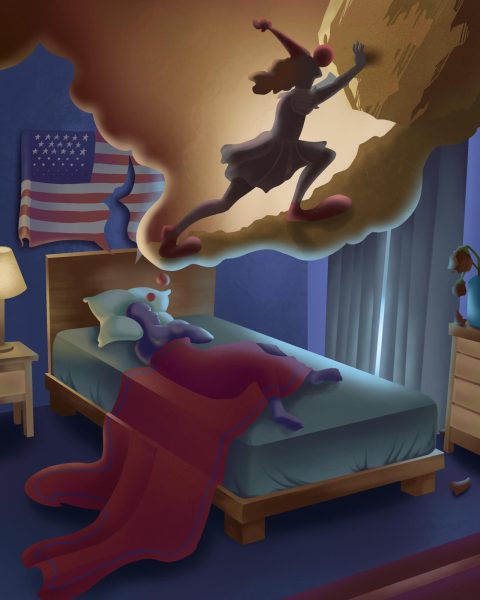Turning Killers into Rockstars
Is the media’s hunger for readership creating celebrities out of monsters?
He’s looking right at the camera with a face that women go nuts for. His hair is long and shaggy, intentionally unkempt. He’s posing like a bad ass because in his mind and the minds of many fans, he is. He pushed the boundaries and made a name for himself in American history. So much so that Rolling Stone even stuck him on their cover, something many musicians would kill for. And he did.
I’m not talking about the prolific and influential lead singer of the Doors. I’m talking about Dzhokhar Tsarnaev, one of the Boston Bombers.
This idolization of criminals, terrorists, and mass murderers is not uncommon nor is it something that is immediately recognized. For as long as people have been able to communicate, the infamous have been glorified in ways that make them seem like the real-life anti-hero of the latest deranged television show.
Take Jack the Ripper. In the late 1800s, a criminal lurked the streets of Whitechapel, London. Investigators would never bring him to justice. Although there are still many reports of gruesome murders linked to the infamous killer, only five have been officially recognized as part of the case.
The killings themselves also marked the beginning of a trend that would continue for the next 200 years into the present day. With detailed letters being mailed to authorities and the savageness of the murders, journalists went mad for the Ripper. The story became a worldwide media frenzy. Even to this day, people are obsessed with the story, developing multiple theories on who the killer could have been. Despite the age of the story, people are still glorifying the unknown murderer by continuing to search for answers and understand the motives.
Similarly, after the Boston Bombings many people from across the globe tried to enter the minds of the two terrorists. Tsarnaev, who was taken into custody and put on trial, has become a dark celebrity who is not cast as a horrendous individual but as an attractive bad boy. To give an example, if a person were to Google “Boston Bombers,” one of the first suggestions that pops up is “Boston Bomber cute one.”

It is hard to understand — or believe for that matter — that anyone could or would find a killer terrorist attractive. But it’s unfortunately not uncommon nor unique to the Boston Bomber.
In November of 2013, a woman known as Star attempted to marry prolific cult leader and killer Charles Manson. Although she allegedly wanted to do so only so she could display his body after his death, which apparently is a thing, it’s not something out of the ordinary for admires of killers. According to Rolling Stone (no surprise there) the then 25-year-old woman moved to Corcoran, Calif., to be near Manson and has been visiting the killer since she was 19. But he’s old news, what abut Tsarnaev?
In a January article published by Refinery29, three women are interviewed who show sympathy and admiration for the Boston Bomber. Many of them, the article claims, are woman in their 30s and 40s who believe Tsarnaev to be innocent.
One woman, a freelance writer identified by the pseudonym Karin Friedmann, covered the trial on her blog and even referred to Tsarnaev as a Christ-like figure. “He gives people from different backgrounds something to talk about. It is one of the things that made me passionate about the issue; as a local, I felt that I owed it to all his supporters to be at the courtroom and tell them what was happening,” she told the magazine.
And she isn’t the only one, nor is Tsarnaev the only killer who has somehow become an object of people’s affection. On the popular blogging site, Tumblr, there is a faction of people obsessed with serial killers and mass murderers. They are called the “serial killer fandom.” You don’t have to dig deep to see the level of admiration these people have for notorious killers. Some people post art, others long letters to the killers, and some even try to justify their deeds. Is it wrong, is it insensitive, is it insane?
Moreover, with shows like Dexter and The Following, the romanticism of murder and the charm of the anti-hero murderer character seems to be branching into the real media’s representation of actual crimes and criminals.
The question many forget to ask is, “Why?” Why are these individuals being sensationalized for killing other Americans? Why would Tsarnaev have a fan base for killing and maiming so many innocent, unsuspecting, victims? Perhaps it has something to do with his appearance on Rolling Stone’s cover.
On the July 2013 cover of the magazine, Tsarnaev was placed in a way that mirrored a popular and well known photo of Doors singer Jim Morrison. The cover received mixed reviews with some people praising the magazine for its bold decision while others were outraged at the perceived insult made to the murdered Bostonians. In response, Rolling Stone added an editor’s note to the story online. It read:
Our hearts go out to the victims of the Boston Marathon bombing, and our thoughts are always with them and their families. The cover story we are publishing this week falls within the traditions of journalism and Rolling Stone’s long-standing commitment to serious and thoughtful coverage of the most important political and cultural issues of our day. The fact that Dzhokhar Tsarnaev is young, and in the same age group as many of our readers, makes it all the more important for us to examine the complexities of this issue and gain a more complete understanding of how a tragedy like this happens. –THE EDITORS
Still, the damage, or in this case glorification, was done. The magazine had, perhaps unwittingly, turned this terrorist into a celebrity. Tsarnaev was no longer a villainous murderer whose goal was to harm and kill as many people as possible. Instead, he become a tragic victim of society. He was demented, lost, a distraught teen to be pitied for his lapse in judgement. And with that came his infamy.
“I didn’t like it when it happened. It felt like the cover romanticized the bomber by granting him a platform, inadvertently or not,” said Vanessa Solis. “I know Rolling Stone likes to court scandal with its covers, but this one was distasteful. It sends a message to would-be terrorists that their efforts are rewarded with infamy…But also just plain old fame. It’s gross.”
Solis, a city employee from Alhambra, Calif. and former Mt. SAC college media editor, said she believes that this kind of glorification comes from societies obsession with the grotesque, and need to understand tragedy. “People get fascinated by things they can’t understand, like the horrors of terrorism. They revel in gory details and act shocked but want to read more. I don’t think we should feed that.”
But we do. In fact, researchers have found that that may be increasing the incidents of violence and shootings. According to an article published in ScienceDaily, scientists from Arizona State University and Northeastern Illinois University found that mass killings and school shootings are contagious. As in mass killings seem to spread in a similar manner to disease.
Using a contagion model, the scientists — lead by study author Sherry Towers — found that there is approximately 13 days in which a copycat may strike. They also found that nearly 20 to 30 percent of killings are attributed to contagion.
“It occurred to us that mass killings and school shootings that attract attention in the national news media can potentially do the same thing, but at a larger scale,” Towers said, citing data that established school suicides could also be contagious in an interview with ScienceDaily.
“While we can never determine which particular shootings were inspired by unconscious ideation, this analysis helps us understand aspects of the complex dynamics that can underlie these events.”
So with that new data, would it not be in the best interest of the general public for media to cover these stories as news as opposed to sensationalizing the perpetrators? It would seem so, however Towers’ data is relatively new (published in July 2015) and not many people may not be looking at it from a viral perspective or they may not be aware these findings exist.
But how does that relate to the issues at hand? For one thing, the ringleader of the Paris attacks has been hailed as a “mastermind” by various media outlets due to the nature and magnitude of the attacks. Media entities such as ABCNews, DailyMailUK, Reuters, and The Telegraph are just a few to actually call the terrorist, Abdelhamid Abaaoud, a mastermind. And although some may not see that reference as a big deal, whichever way you spin it, the term “mastermind” is generally used for someone who is genius.
“I mean, that word would describe him, I mean what he did was terrible but he is the originator of that and I think mastermind is, if that is what you are referring to is as an appropriate term,” said 20-year-old Joey Rubio. “I mean if he thought of that by himself, that is his credit and his origin, It’s all him.”

But is it really? Others are apprehensive about using the term however some people don’t know how else to describe Abaaoud. “I could see how that could come off as like not… I don’t know… I would consider it… I wish there was a better word to use that didn’t sound like it was something that could also be used for good because they are people you know,” said Cal Poly Pomona student Elizabeth Rainey.
“But I mean, like technically in the terms he was [a mastermind] with everything that he pulled off and how many attacks there were and how many people he was able to hurt or kill.”
Despite the meaning of the word, others are simply refusing to see it that way. “Calling the attacker a ‘mastermind’ is careless language. The words we choose when referring to attackers matter,” said Solis. “‘Mastermind’ has devious, maybe even positive, connotations. I don’t think we should be calling terrorists masters of anything. It’s entirely too flattering. And it does a disservice to the victims of the killers to make it seem like they fell victim to some brilliant plan rather than something insidious and cowardly.”
Media business is a complicated industry trying to balance content with advertising. To stay afloat and relevant in the industry, news organizations have had to constantly meet the demand of a society that want’s information in the quickest and simplest method possible. This has led news agencies to continue a 24/7 news cycle that is not always accurate, but who cares when people are getting the info right? Wrong.
During major tragedies and events, the news has many times been on the wrong end of journalistic ethics. Take the 2011 Tucson shooting where Arizona Senator Gabrielle Giffords and eight others were shot. Giffords, a Democratic Senator, was holding a town hall meeting when Jared Lee Loughner shot the senator point blank in the head and then turned and fired at the crowd.
During the tragedy, in attempts to be first to break the news to their audience, NPR initially reported that the senator had been killed. Let that sink in a moment. Don’t get it yet, let me explain: the job of the news is not only to hold those with authority accountable and open to informed public criticism but to also accurately report the facts. By not waiting a few moments longer, and in their rush to break a national story, NPR mislead its audience. The situation was even the basis of an episode of the popular HBO show, The Newsroom. So where does this fit into the infamy of terrorists?
It all goes back to the way journalists report. “People want to make what happens with terrorist attacks into a neat narrative. ‘Oh, he had a bad home life growing up.’ Or ‘he had a hard time socializing in school.’ Or ‘he was lonely, or mentally ill.’ None of these factors is guaranteed to produce a terrorist, and I think most people know that,” said Solis.
“It’s just human nature to search for the story that makes sense, when little about terrorists or mass killings makes any sense. When Sandy Hook happened I don’t think anyone could have predicted someone would murder children in mass numbers. It’s senseless. We want to know why. I think the answers are systemic rather than just anomalies. This is more about home grown terror rather than what happened in Paris.”
But the same theory applies to the Paris attacks. Through social media, reports were flooding in with misinformation and false reports. At one point, it was believed that French president, François Hollande, had been killed. However, the truth is that although Hollande was attending a soccer match where three suicide bombings took place, he was evacuated to safety.
“We live in a rapidly changing media world. Stories spread virally. Narratives, even wrong ones, even ones that are just speculation, spread along with the bare facts,” said Solis.
“Modern mass killings are being reported as they happen. Tweets were a primary source during the Paris attacks. It’s impossible to erase that.”
Solis said that she believes people want to understand what happened and why, however she thinks that sometimes there is no answer other than hate. “I don’t think it’s entirely possible to put together a story as it happens using careful language. I saw reporters struggle with not speculating live on the air and on the radio. It’s human nature. It’s a battle against our basic instincts.”
So what then? How do we remove the sensationalizing and glorification given to these types of killers? There is no easy answer. Solis suggests the media stop indulging the fetishization of the killings and to stop “putting killers on the covers of magazines.”
“Stop searching for a neat narrative in their lives. That’s for the experts to do, not the general public. I think everyone has a right to the story, don’t get me wrong. I just don’t think they need to know everything about the killers’ lives, and I don’t think it should be that easy to bring their names to mind.”
Solis added this applies to infamous characters throughout history. “We romanticize a lot of it. Old murders are fascinating, I’ll grant you that. But back then people were not reporting Bonnie and Clyde or Jack the Ripper on a 24-hour news cycle. Manson and the reportage surrounding him and his followers was a modern phenomenon.”
There is no easy answer to this idolization and a lot of it comes from the media itself. And by media I mean journalists and reporters trying to be first to break a story. The first to have the details and pull in viewers for greater advertising revenue. When the shift happened exactly is unknown and there isn’t an easy solution. Solis agrees, and acknowledges the need for change.
“I think you know a bunch of this… Policing your own language is a reporter’s job. ‘Alleged.’ We need to do better.”
Illustration art by Adam Michael Valenzuela
Header Gif by Albert Serna Jr.







